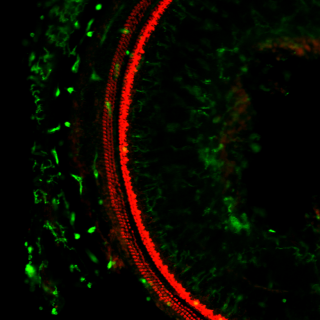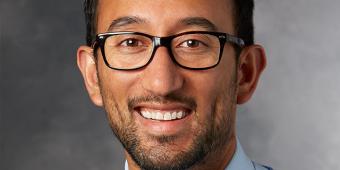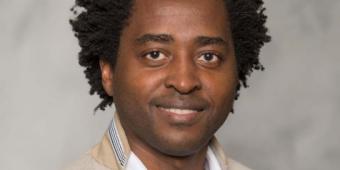Sensory Hearing Loss
The World Health Organization recognizes CSOM as the leading cause of permanent SHL in the developing world. To find out why this occurs we developed and validated a novel model published in Science Advances. Until now there has not been an animal model of CSOM that replicates human disease. We use cutting edge bacterial genetic fluorescent labeling allowing us to track the ear disease real time. Our technically gifted research team samples microscopic amounts of inner ear fluid to study changes in the cochlea that occur during infection. We are studying hair cell damage over time, the innate immune response and inflammatory alterations that occur in the cochlea during CSOM. Our ultimate goal is to find out the mechanism that causes sensory hearing loss, further, to protect the hearing and provide solutions for treating hearing loss in CSOM.
Khomtchouk, Kelly M., Ali Kouhi, Anping Xia, Laurent Adonis Bekale, Solange M. Massa, Jolien M. Sweere, Daniel Pletzer, Robert E. Hancock, Paul L. Bollyky, and Peter L. Santa Maria. “A Novel Mouse Model of Chronic Suppurative Otitis Media and Its Use in Preclinical Antibiotic Evaluation.” Science Advances 6, no. 33 (August 2020): eabc1828. https://doi.org/10.1126/sciadv.abc1828.
Bacterial pathogenesis
We study in vitro and in vivo how the bacteria establish their infection niche and interact with the host immune system. We are redefining how the specialty understands chronic infection through the study of persister cell concepts. Persister cells are low metabolic cells that evade antibiotic attack not through resistance but tolerance because of their low metabolic state and ability to repair. We do this through direct study of the infections that occur in our patients and studying bacterial samples provided to us through collaborations that occur across the world.
Santa Maria, Peter L., Adam C. Kaufman, Brian Bacacao, Anthony Thai, Xiaohua Chen, Anping Xia, Zhixin Cao, Ayman Fouad, and Laurent A. Bekale. “Topical Therapy Failure in Chronic Suppurative Otitis Media Is Due to Persister Cells in Biofilms.” Otology & Neurotology: Official Publication of the American Otological Society, American Neurotology Society [and] European Academy of Otology and Neurotology 42, no. 9 (October 1, 2021): e1263–72. https://doi.org/10.1097/MAO.0000000000003222.
 We now have the necessary tools to follow the changes that occur in the inner ear in CSOM, identify potential mechanisms of injury, and identify targets for prevention and treatment.
We now have the necessary tools to follow the changes that occur in the inner ear in CSOM, identify potential mechanisms of injury, and identify targets for prevention and treatment.

Principal Investigator

Lead Research Scientist

Research Scientist
